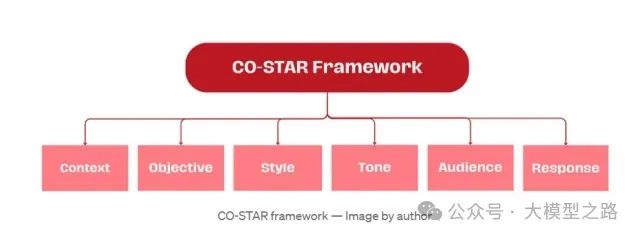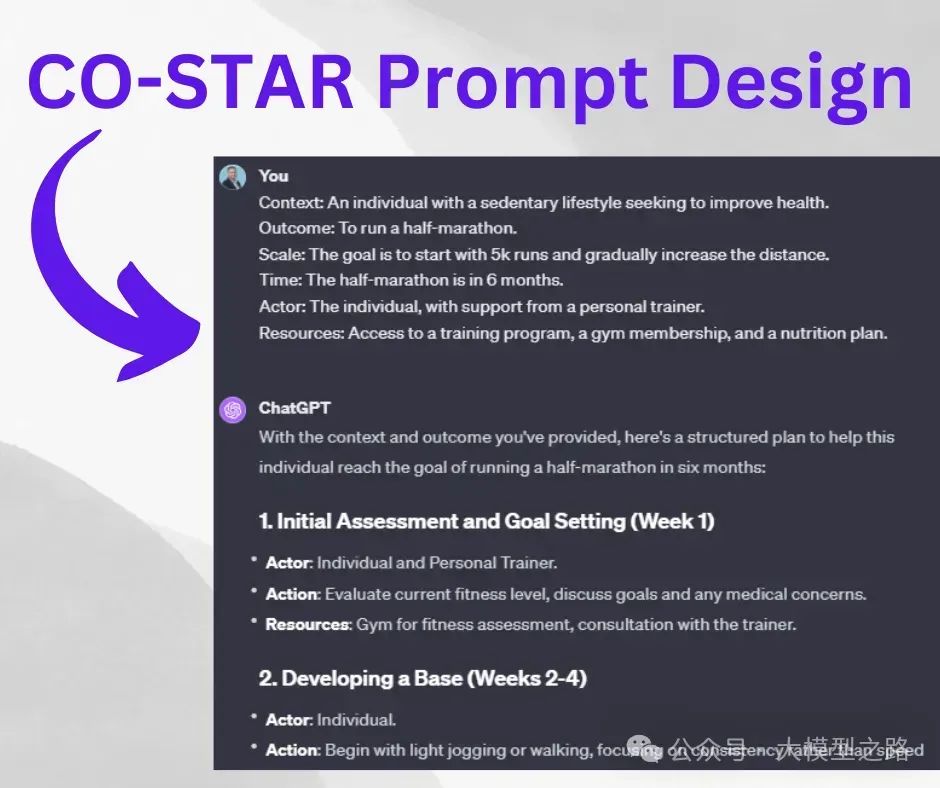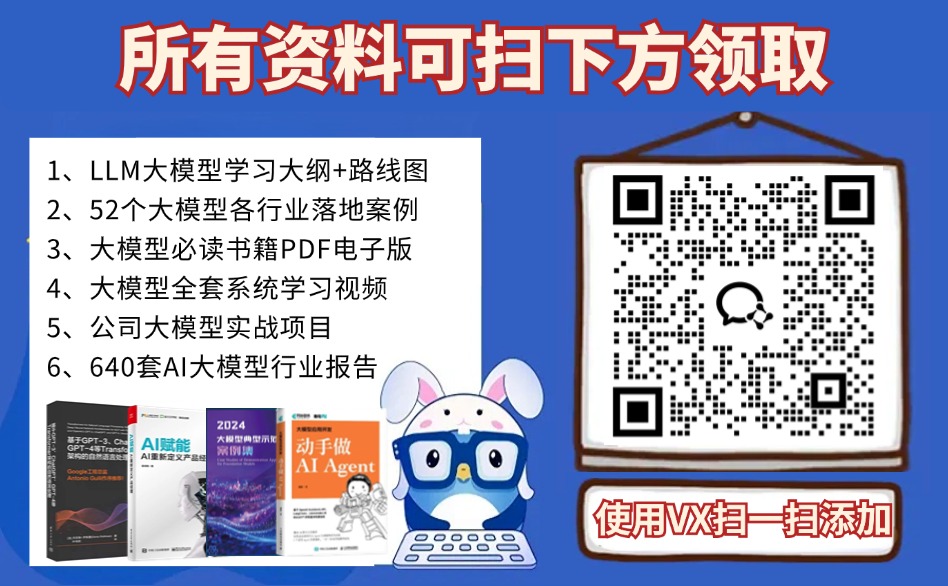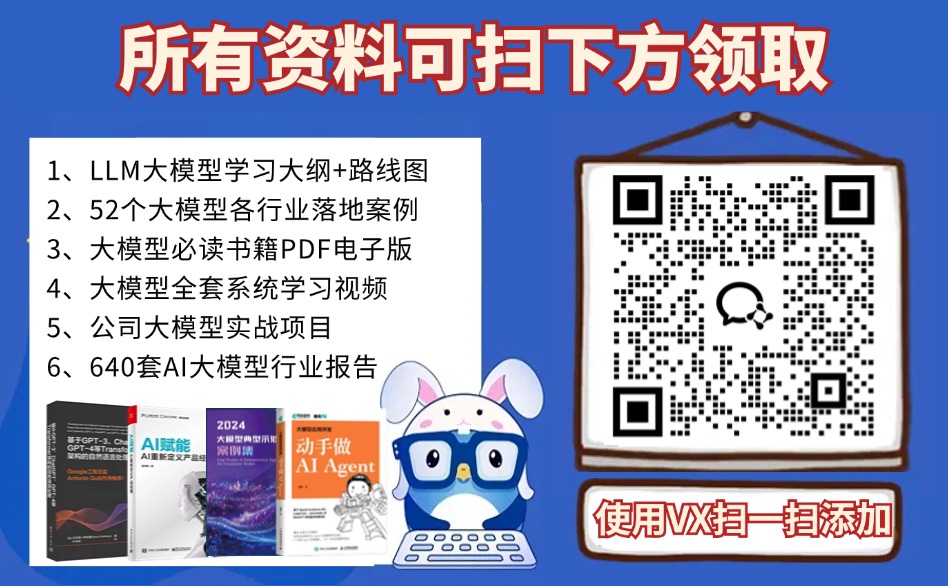我们在各个领域,无论是商业决策、项目管理还是个人成长规划,有效的目标设定都是成功的关键。CO-STAR 架构作为一种结构化的目标设定方法,为我们提供了一个全面且系统的框架。当我们将其应用于 prompt 设计领域时,它同样展现出了巨大的潜力和价值。今天我们一起聊一下 CO-STAR 架构在prompt中的应用。
一、CO-STAR 架构概述

1、Context
Context 是 CO-STAR 架构的基础。它要求我们明确目标所处的背景、环境或相关的情境因素。在 prompt 设计中,这意味着我们需要了解用户提出问题的背景、问题所涉及的领域以及可能影响回答的各种条件。例如,如果我们要设计一个关于医疗领域的 prompt,我们需要考虑当前医疗行业的发展趋势、常见的疾病类型、治疗方法以及患者和医护人员的常见需求等背景信息。只有充分理解这些背景因素,我们才能设计出符合实际需求的 prompt。
2、Outcome
Outcome 明确了最终的目标。对于 prompt 设计来说,这就是我们希望通过 prompt 引导得到的理想回答或结果。比如,我们希望用户能够详细阐述某个概念的定义和应用,或者提供解决某个问题的具体步骤。清晰地定义结果有助于我们聚焦于核心问题,避免 prompt 过于模糊或宽泛,从而提高回答的质量和针对性。
3、Scale
Scale 决定了结果的大小或范围。在 prompt 设计中,我们需要考虑问题的深度和广度。例如,我们是要求用户提供一个简要的概述,还是进行深入的分析和探讨?我们是关注局部的问题解决,还是涉及整个系统或领域的宏观视角?合理确定规模可以帮助我们更好地引导用户提供符合我们期望的回答,同时也能让用户明确回答的方向和重点。
4、Time
Time 要素强调了时间线的重要性。虽然在 prompt 设计中时间的体现可能不像在其他目标设定场景中那样直接,但它仍然具有一定的影响。例如,我们可以通过一些方式暗示回答的紧迫性或时间跨度。我们可以问 “在短期内如何解决这个问题?” 或者 “长期来看,这个领域的发展趋势会是怎样的?” 这样的 prompt 能够引导用户从不同的时间维度来思考和回答问题。
5、Actor
Actor 指的是谁将执行相关的行动。在 prompt 设计中,Actor 通常就是回答问题的用户。我们需要了解用户的身份、知识水平和能力范围,以便设计出适合他们回答的 prompt。如果用户是专业人士,我们可以使用更专业的术语和更复杂的问题;如果用户是普通大众,我们则需要使用通俗易懂的语言和更基础的问题。
6、Resources
Resources 涉及到完成目标所需的工具、信息或支持。在 prompt 设计中,我们可以考虑用户可能拥有的资源。例如,如果我们知道用户可以访问某些数据库或文献,我们可以在 prompt 中引导他们利用这些资源来回答问题。同时,我们也可以提供一些必要的背景知识或提示信息,作为回答问题的辅助资源。

二、基于 CO-STAR 架构的 prompt 设计实例分析
实例一:商业战略决策 prompt
Context: A mid-sized tech company faces stagnation in its market growth.
Outcome: To increase market share by 15%.
Scale: The target is set for regional expansion before considering national scaling.
Time: The goal is to be achieved within 18 months.
Actor: The marketing and sales teams, led by the Chief Marketing Officer.
Resources: A budget allocation for market research, advertising, and a skilled salesforce.
在这种情况下,CO-STAR框架帮助公司将其资源和努力对齐到一个具体、可衡量的目标上。清晰的时间线和明确的参与者确保每个团队成员都知道他们的角色以及背后的紧迫性。
结果:
To achieve a 15% increase in market share within 18 months through regional expansion, the mid-sized tech company will need a well-structured strategy. Here's a plan that can be executed by the marketing and sales teams under the leadership of the Chief Marketing Officer:
1. Market Research and Analysis
Objective: Understand the regional market dynamics, customer preferences, and competitors.
Actions:
Conduct comprehensive market research to identify potential regions for expansion.
Analyze competitors' strengths, weaknesses, and market positioning.
Gather data on customer needs and preferences in the target regions.
Expected Outcome: A detailed report on market opportunities, competitive landscape, and customer insights.
2. Product Adaptation and Development
Objective: Tailor products/services to meet regional demands.
Actions:
Based on research findings, modify existing products or develop new offerings.
Focus on unique selling propositions that distinguish the company from competitors.
Expected Outcome: Products/services that are well-suited for the regional market.
3. Salesforce Training and Development
Objective: Equip the sales team with skills and knowledge for regional markets.
Actions:
Provide training on regional market characteristics, cultural nuances, and sales techniques.
Develop a sales playbook tailored to regional strategies.
Expected Outcome: A highly skilled and regionally knowledgeable salesforce.
4. Marketing Campaigns
Objective: Increase brand awareness and generate leads in the target regions.
Actions:
Design and implement targeted advertising campaigns.
Leverage digital marketing, including social media, SEO, and content marketing.
Host or participate in regional events and trade shows.
Expected Outcome: High brand visibility and an influx of leads.
5. Channel and Partnership Development
Objective: Expand market reach through strategic partnerships and channels.
Actions:
Identify and partner with local distributors, resellers, or influencers.
Establish strategic alliances with complementary businesses or tech companies.
Expected Outcome: Extended market reach and enhanced market penetration.
6. Performance Monitoring and Adaptation
Objective: Track progress and adapt strategies as needed.
Actions:
Implement a robust system for tracking sales, market share, and marketing ROI.
Regularly review performance against targets and adjust strategies accordingly.
Expected Outcome: Ability to quickly respond to market changes and maintain growth trajectory.
7. Customer Feedback and Engagement
Objective: Build a loyal customer base and improve offerings.
Actions:
Establish channels for customer feedback and engagement.
Use customer insights to improve products and services continuously.
Expected Outcome: Strong customer relationships and enhanced product appeal.
Budget Allocation
Allocate the budget across market research, product development, sales training, marketing campaigns, and channel partnerships.
Regularly review budget utilization against outcomes to ensure efficient use of resources.
Timeline
Months 1-3: Market research and strategy development.
Months 4-6: Product adaptation, salesforce training, and beginning of marketing campaigns.
Months 7-12: Intensive marketing efforts, sales expansion, and partnership development.
Months 13-18: Performance review, strategy adaptation, and push for market share growth.
Risk Management
Prepare for potential risks such as market unpredictability, regulatory changes, and competitive responses.
Develop contingency plans to address these risks promptly.
By following this plan, the company can effectively leverage its resources to increase its market share in the targeted regions, setting a strong foundation for future national scaling.
实例二:个人学习计划 prompt
Context: An individual with a sedentary lifestyle seeking to improve health.
Outcome: To run a half-marathon.
Scale: The goal is to start with 5k runs and gradually increase the distance.
Time: The half-marathon is in 6 months.
Actor: The individual, with support from a personal trainer.
Resources: Access to a training program, a gym membership, and a nutrition plan.
对于像健身这样的个人目标,CO-STAR框架提供了一种结构化的方法,将跑半程马拉松这一艰巨任务分解成可管理的步骤。它还强调了正确的支持和资源的重要性。
结果:
With the context and outcome you've provided, here's a structured plan to help this individual reach the goal of running a half-marathon in six months:
1. Initial Assessment and Goal Setting (Week 1)
Actor: Individual and Personal Trainer.
Action: Evaluate current fitness level, discuss goals and any medical concerns.
Resources: Gym for fitness assessment, consultation with the trainer.
2. Developing a Base (Weeks 2-4)
Actor: Individual.
Action: Begin with light jogging or walking, focusing on consistency rather than speed or distance.
Resources: Use local tracks or treadmills at the gym, follow the training program for beginners.
3. 5k Training (Weeks 5-8)
Actor: Individual, with guidance from the trainer.
Action: Gradually increase running distance to 5k. Introduce interval training and light strength training.
Resources: Training program tailored to 5k runs, gym for strength training.
4. Building Endurance (Weeks 9-16)
Actor: Individual.
Action: Increase weekly mileage, include one long run per week. Incorporate rest days and cross-training.
Resources: Training program, gym for cross-training.
5. 10k Training (Weeks 17-24)
Actor: Individual, with check-ins from the trainer.
Action: Work towards running 10k. Focus on maintaining a steady pace and improving endurance.
Resources: Advanced training plans, possibly group running sessions for motivation.
6. Half-Marathon Specific Training (Weeks 25-26)
Actor: Individual.
Action: Introduce longer runs that are closer to half-marathon distance. Practice race pace.
Resources: Customized half-marathon training plan.
7. Taper and Prepare (Weeks 27-26)
Actor: Individual, with support from the trainer.
Action: Reduce mileage to rest the body. Focus on nutrition, hydration, and mental preparation.
Resources: Nutrition plan, sessions with the trainer for strategy and motivation.
8. Race Week (Week 26)
Actor: Individual.
Action: Very light running or rest. Mental preparation and strategy finalization.
Resources: Trainer for last-minute advice, nutrition plan for race day.
Throughout the 6 Months:
Nutrition: Follow a balanced diet that supports increased activity levels.
Hydration: Ensure adequate hydration, especially on training days.
Rest: Prioritize rest and sleep to aid recovery.
Monitoring and Adjustment: Regular check-ins with the trainer to adjust the program as needed.
Post-Half-Marathon:
Reflection and Recovery: Post-race recovery and evaluation of the experience with the trainer.
Setting New Goals: Depending on the experience, setting new goals for future races or fitness achievements.
This plan balances gradual progress with the need to avoid injury and burnout, ensuring the individual is well-prepared for the half-marathon challenge.
三、CO-STAR 架构对 prompt 设计的启示

1、提高问题的针对性
通过明确 Context、Outcome、Scale 等要素,我们可以设计出更具针对性的 prompt。这样的 prompt 能够引导用户准确地理解问题的核心和要求,从而提供更符合期望的回答。避免了一般性的、模糊的问题,提高了信息获取的效率和质量。
2、适应不同用户群体
考虑 Actor 要素,我们可以根据用户的身份和能力来设计 prompt。对于专业用户,我们可以提出更具挑战性和专业性的问题;对于普通用户,我们可以简化问题并使用通俗易懂的语言。这样可以确保不同用户群体都能够参与回答,扩大了 prompt 的适用范围。
3、引导全面思考
CO-STAR 架构要求我们从多个维度考虑问题,这也促使我们在 prompt 设计中引导用户进行全面思考。例如,通过提示 Time 要素,让用户从不同的时间角度考虑问题;通过强调 Resources 要素,让用户充分利用各种资源来回答问题。这种全面思考有助于提高回答的完整性和深度。
4、促进有效沟通
一个好的 prompt 是与用户进行有效沟通的关键。通过合理运用 CO-STAR 架构,我们可以设计出清晰、明确、易懂的 prompt,减少用户对问题的误解,提高用户回答问题的积极性和准确性,从而促进了人与系统之间的有效沟通。

CO-STAR 架构为 prompt 设计提供了一个系统、全面的方法。通过对 Context、Outcome、Scale、Time、Actor 和 Resources 等要素的深入理解和应用,我们可以设计出更优质、更有效的 prompt。这些 prompt 能够提高问题的针对性,适应不同用户群体,引导用户进行全面思考,并促进人与系统之间的有效沟通。在未来的 prompt 设计中,我们应该充分利用 CO-STAR 架构的优势,不断优化 prompt 的设计([Vertex AI Prompt Optimizer:提升Prompt Engineering(提示工程)的效率与质量],以获取更有价值的回答和信息。同时,我们也可以进一步探索 CO-STAR 架构在其他领域的应用,不断拓展其应用范围和价值。
读者福利:如果大家对大模型感兴趣,这套大模型学习资料一定对你有用
对于0基础小白入门:
如果你是零基础小白,想快速入门大模型是可以考虑的。
一方面是学习时间相对较短,学习内容更全面更集中。
二方面是可以根据这些资料规划好学习计划和方向。
包括:大模型学习线路汇总、学习阶段,大模型实战案例,大模型学习视频,人工智能、机器学习、大模型书籍PDF。带你从零基础系统性的学好大模型!
😝有需要的小伙伴,可以保存图片到wx扫描二v码免费领取【保证100%免费】🆓

👉AI大模型学习路线汇总👈
大模型学习路线图,整体分为7个大的阶段:(全套教程文末领取哈)

第一阶段: 从大模型系统设计入手,讲解大模型的主要方法;
第二阶段: 在通过大模型提示词工程从Prompts角度入手更好发挥模型的作用;
第三阶段: 大模型平台应用开发借助阿里云PAI平台构建电商领域虚拟试衣系统;
第四阶段: 大模型知识库应用开发以LangChain框架为例,构建物流行业咨询智能问答系统;
第五阶段: 大模型微调开发借助以大健康、新零售、新媒体领域构建适合当前领域大模型;
第六阶段: 以SD多模态大模型为主,搭建了文生图小程序案例;
第七阶段: 以大模型平台应用与开发为主,通过星火大模型,文心大模型等成熟大模型构建大模型行业应用。
👉大模型实战案例👈
光学理论是没用的,要学会跟着一起做,要动手实操,才能将自己的所学运用到实际当中去,这时候可以搞点实战案例来学习。

👉大模型视频和PDF合集👈
观看零基础学习书籍和视频,看书籍和视频学习是最快捷也是最有效果的方式,跟着视频中老师的思路,从基础到深入,还是很容易入门的。


👉学会后的收获:👈
• 基于大模型全栈工程实现(前端、后端、产品经理、设计、数据分析等),通过这门课可获得不同能力;
• 能够利用大模型解决相关实际项目需求: 大数据时代,越来越多的企业和机构需要处理海量数据,利用大模型技术可以更好地处理这些数据,提高数据分析和决策的准确性。因此,掌握大模型应用开发技能,可以让程序员更好地应对实际项目需求;
• 基于大模型和企业数据AI应用开发,实现大模型理论、掌握GPU算力、硬件、LangChain开发框架和项目实战技能, 学会Fine-tuning垂直训练大模型(数据准备、数据蒸馏、大模型部署)一站式掌握;
• 能够完成时下热门大模型垂直领域模型训练能力,提高程序员的编码能力: 大模型应用开发需要掌握机器学习算法、深度学习框架等技术,这些技术的掌握可以提高程序员的编码能力和分析能力,让程序员更加熟练地编写高质量的代码。
👉获取方式:
😝有需要的小伙伴,可以保存图片到wx扫描二v码免费领取【保证100%免费】🆓






















 3024
3024

 被折叠的 条评论
为什么被折叠?
被折叠的 条评论
为什么被折叠?








